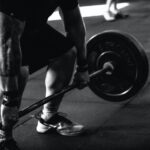
In our journey to lose weight, it’s crucial to understand how to take measurements for weight loss and their role in tracking our progress. Let’s delve deeper into how we can effectively measure our body mass index and composition for an accurate view of our weight loss journey.
Table of Contents (click to expand)
Understanding the Importance of Taking Measurements for Weight Loss
The journey of losing weight isn’t solely about shedding pounds but also about transforming our body composition. While weight can fluctuate daily due to factors such as water retention, measuring body fat percentage gives a more accurate picture of progress. By regularly taking our body fat percentage measurements, we can see how much fat we’re losing and whether we’re gaining muscle, better understanding body changes over time.
Weight Loss vs. Fat Loss: A Crucial Distinction
In the weight loss process, it’s essential to differentiate between losing weight and losing fat. Weight comprises everything in your body, including muscle mass, fat, and water. Losing weight could mean losing any of these elements. Conversely, losing fat specifically targets body fat, aiming to maintain or even increase lean muscle tissue. This is why we measure body composition – to determine our body fat percentage and monitor changes in skeletal muscle tissue and fat.
Why You Shouldn’t Solely Depend on the Scale to Measure Weight Loss
Depending solely on the scale to measure weight loss has its limitations. It can’t distinguish between the weight of muscle, fat, and water in our bodies. An individual could be gaining muscle from strength training and losing fat simultaneously, and the scale might measure weight loss but not reflect this progress. Consequently, we must complement the scale’s reading with body measurements to get the whole story.
How Body Measurements Offer a More Comprehensive View of Your Weight Loss Progress
Taking body measurements gives a more comprehensive picture of our weight loss progress. As we lose fat and gain muscle, our body weight may stay the same, but our body shape changes, reflecting less space taken up by fat and more by muscular body parts. For example, our waist might be slim, and our arms might become more defined and muscular.
Step-by-Step Guide: How to Take Body Measurements for Weight Loss
You’ll need a cloth measuring or tape measure to take body measurements. Here’s how to do it:
- Waist: Measure around the smallest part of your waist, just above the belly button.
- Hips: Measure around the widest point of your buttocks.
- Chest: Measure around the chest at the nipple line.
- Thighs: Measure around the most significant part of each thigh.
- Arms: Measure around the most significant part of each upper arm.
Make sure to take each measurement twice to confirm accuracy. Remember, consistency is key – always measure under the same conditions.
The Key Body Parts to Measure for Weight Loss
When measuring for weight loss, it’s important to take body measurements focusing on specific body parts. For instance, the waist is a critical area since a larger waist circumference can indicate a higher risk of heart disease. Hips and thighs are other vital areas to measure for weight loss, as fat stored in these areas is often a focus of weight loss efforts. Also, measuring the chest and arms helps track progress in these areas as you lose weight and potentially gain muscle.
How Often Should You Take Your Body Measurements?
The best bet for tracking progress without becoming overly obsessed is to take body measurements every two weeks. This timeline is enough to show changes without encouraging an unhealthy fixation on daily fluctuations.
Understanding the Results: Interpreting Your Body Measurements
Interpreting body measurements for weight loss involves understanding the slow process of change in your body. If your sizes are decreasing, you’re losing your body fat, too, regardless of whether your weight on the scale is moving. If your measurements stay the same but feel more substantial, you might gain muscle while losing fat. Remember, progress isn’t just about reaching your goal weight; it’s also about transforming your body composition.
Balancing Body Measurements and Scale Readings in Weight Loss Tracking
Using body measurements and scale readings to track progress in your weight loss routine offers a complete picture of your progress. While the scale shows overall weight loss, body measurements can show you where you’re losing fat and if you’re gaining muscle.
Incorporating Body Measurements into Your Weight Loss Plan
Consider incorporating taking measurements for weight loss into your routine. It will provide valuable feedback on your progress, keep you motivated, and help you adjust your diet and exercise plan.
Challenges in Taking Body Measurements and How to Overcome Them
While taking body measurements is useful in your weight loss journey, it’s not without challenges. These may include ensuring you’re measuring the same spots each time and knowing how to maintain the right tension on the tape measure. The solution lies in practicing consistency and patience.
Benefits of Body Measurements Beyond Weight Loss
Beyond helping you track weight loss progress, consistent measuring can contribute to a healthier lifestyle. It can motivate you to maintain or adopt healthier habits as you see your body change, lose weight, and your health improves.
Case Study: Success Stories of People Who Incorporated Body Measurements in Their Weight Loss Journey
There are many success stories from people who incorporated measuring body composition measurements into their weight loss plan. By focusing on body composition changes rather than solely on weight loss, they could see progress even when their scale didn’t show it, keeping them motivated and on the right track.
Expert Opinions on Body Measurements and Weight Loss
Fitness professionals often stress the importance of body measurements in losing weight. They argue that it provides a more accurate reflection of body type of progress, focusing on fat loss rather than simply losing weight. It helps maintain a healthier focus on body changes rather than just numbers on a scale.
How Body Measurements Can Motivate You in Your Weight Loss Journey
Regularly taking measurements and seeing your progress will motivate you to continue your weight loss journey. Each inch lost can be a powerful motivation to continue working towards your body weight and goals.
Tips to Stay Consistent in Taking Body Measurements
Consistency is critical when taking measurements for weight loss. Here are a few tips: Always measure your body under the same conditions (ideally, in your birthday or bathing suit first thing in the morning), and use the same measuring tape every time.
Common Misconceptions About Taking Measurements for Weight Loss
A common misconception about taking measurements for weight loss is that the scale and they don’t matter as long as the scale’s number is going down. However, as discussed, the scale doesn’t tell the whole story of your body’s transformation. Measurements can give a much clearer picture of how your body is changing.
Advanced Techniques: Using Body Composition Scanners for Precise Measurements
Modern technology offers advanced techniques to measure body composition. Body composition scanners can provide more accurate data than a simple measuring tape, allowing you to track your progress precisely.
Professional Help: When to Seek Assistance in Taking Body Measurements
While taking measurements at home can provide a good deal of information about your progress, there are times when professional help might be necessary. For instance, a fitness professional can provide guidance and ensure accuracy if you’re unsure if you’re measuring correctly.
How to Use Measurements to Set Realistic Weight Loss Goals
You can set realistic goals for your weight loss journey using your body measurements. For example, you might aim to lose inches from your waist or hips rather than focusing solely on pounds lost.
The Role of Diet and Exercise in Affecting Body Measurements
Diet and exercise play significant roles in your body shape and measurements. Eating a balanced diet helps promote fat loss and muscle gain, while regular exercise, especially strength training, helps build muscle mass, which can alter your body’s shape and measurements.
Cautions to Consider When Taking Body Measurements
When taking measurements, it’s important to remember that changes may be slow and not to get discouraged. It’s also essential to consistently measure the same areas each time for accurate tracking.
Conclusion: The Power of Body Measurements in Achieving Your Weight Loss Goals
By understanding how to take measurements for weight loss, we can better understand our progress. It offers a fuller picture of our body changes and can be a powerful tool in achieving our weight loss goals.
FAQs: Common Questions About Taking Measurements for Weight Loss
What Measurements to Track for Weight Loss?
When tracking measurements for weight loss, it’s essential to focus on critical areas of your body. These typically include the waist, hips, thighs, chest, and arms. Monitoring changes in these areas can help you understand your body composition shifts as you lose fat and possibly gain muscle. Remember that everyone is unique and carries weight differently, so it’s essential to focus on your changes over time.
Where do you Measure Weight Loss in Inches?
To measure weight loss in inches, focus on the following areas:
- Waist: Measure around your natural waistline—right above your belly button.
- Hips: Measure the circumference around the widest part of your hips.
- Chest: Measure around the fullest part of your chest, at the nipple line.
- Thighs: Measure around the thickest part of your thigh.
- Arms: Measure around the thickest part of your upper arm.
Remember to take these measurements under the same conditions each time for consistency.
What is a Fair Way to Measure Weight Loss?
A fair way to measure weight loss is to use a combination of methods to get a holistic view of your progress. This can include:
- Body Measurements: Taking measurements of your waist, hips, chest, thighs, and arms can provide insight into how your body changes regarding fat loss and muscle gain.
- Scale: Checking your weight can be helpful, but remember, it’s not the only indicator of progress as it doesn’t distinguish between fat, muscle, and water.
- Body Fat Percentage: Consider using a tool or professional service to measure your body fat percentage for a more accurate view of fat loss.
- How You Feel: Listen to your body. If you’re feeling better, having more energy, and your clothes fit better, it’s a good sign that you’re progressing.
How Often Should You Check Your Measurements for Weight Loss?
A good rule of thumb is to check your measurements for weight loss every two weeks. This frequency is enough to see changes, but not so often that it encourages an unhealthy obsession with daily fluctuations. Remember, weight loss and body changes are slow; consistency is critical in tracking progress. Be patient and give your body time to adjust to the new diet and exercise routines.





































